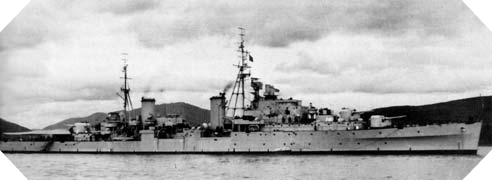HMS Diadem
Index of Allied warships during Operation Neptune
History, technical sheet and photo

H.M.S. Diadem history
The light cruiser H.M.S. (Her Majesty Ship) Diadem (84) belongs to the class Dido type II and entered service in January 1944 after work which began in August 1942.
It is immediately used in the protection of Allied convoys crossing the Atlantic against the possible attacks of submarines and German aircraft.
Deployed during Operation Neptune, the Diadem crossed the Channel on the night of June 5-6, 1944 in the direction of Juno Beach. In charge of opening fire on the Moulineaux battery at Bény-sur-Mer, a German artillery position of four 10 cm guns, as well as strongpoints defended by the 1716th artillery regiment. It is damaged after colliding with a Rhino Ferry and must be repaired.
This incident did not prevent it from participating in missions to support the ground troops in the region of Caen during the whole month of June, before patrolling along the Breton coast: on 12 August 1944, the HMS Diadem sinks the German ship Sperrbrecher 7 Sauerland.
It ended the war in the North Sea where it carried out new patrols and protections of Soviet convoys. On January 28, 1945, it engaged three German destroyers near the Norwegian coast and damaged the Z31. After the Second World War, HMS Diadem was left in reserve from 1950 to 1956 before being sold to Pakistan on July 5, 1957 where it was renamed Babur then Jahangir. In 1961, it was used for the benefit of cadets.
H.M.S. Diadem technical sheet
Creator/User: Britain
Denomination: 84 – H.M.S. Diadem
Class: Dido type II-class light cruiser
Crew: 530 sailors
Armament (1944): 8x twin-tube 133 mm guns, 6x twin-tube 20 mm guns, 3x 37 mm pom-poms guns, 2x 533 mm triple torpedo tubes
Displacement: 7,200 tons
Speed: 32,25 knots
Length: 156 m
Beam: 15,4 m
Draught : 4,3 m
